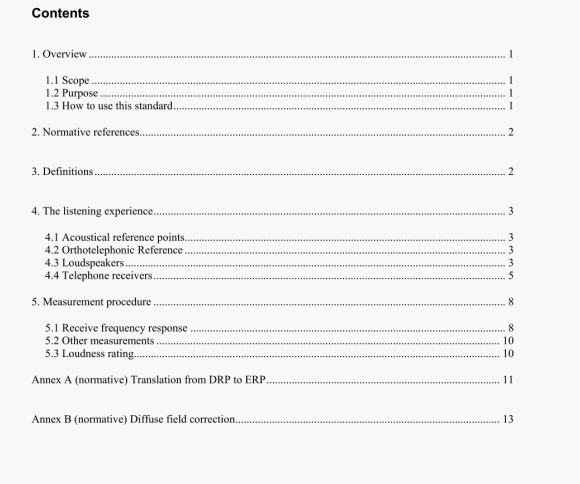IEEE Std 1652:2008 pdf free download.IEEE Standard for the Application of Free Field Acoustic Reference to Telephony Measurements.
Figure I through Figure 9 support measuring telephone receivers and other head-worn devices at the DRP. and then translating to the free field, allowing the receive response to be compared with, for instance, a quality loudspeaker.
5. Measurement procedure
5.1 Receive frequency response
The procedure applies to measurements made at the DRP with ear simulator Type 3.3 (HATS). Ii also applies to measurements made with one of the alternative ear simulators: Type 2. Type 3.2, or Type 3.4. [See ITU-T P.57 (2005) for ear simulator definitions.’J
The receive measuremeni is made according to the standard or specification being used,
To translate the rncasuremcnt to the free field, subtract the free field transformation curve shown in Figure 10 from the frequency response at the DRP. (Subtraction in d14 is equivalent to division in linear units.) Table I includes the R40 values, and Table 2 includes the values at 1/12” octave band center frequencies.
A single, generally applicable transformation curve is used rather than an individually calibrated curve for the particular simulator being used. In this respect, the procedure is different from measurenient of a spcakcrphone using a head and torso simulator. Sec ITU-T P.581 (2000) for more information.
When measuring a receiver, the pinna is deformed to one degree or another, so for this reason alone an individually calibrated curve is not applicable. More important. telecom measurements are made with respect to the orihotelephonic rckrencc. This is a face-to-face conversation in the free field at I m. Therefore, a general free-field-to-DRP transformation is appropriate.
The values in Table l and Table 2 were derived from data supplied by the manufacturer of one head andtorso simulator that meets ITU-T P.58 (1996).The manufacturer ‘s data chosen was the typical free fieldfrequency response magnitude for frontal incidence at zero degrees azimuth and elevation. Then thefollowing postprocessing was performed:
a)Curve values from 200 Hz and below were set to OdB.In the published curve, these values were
near zero, and most likely were measurement noise.
b)The original data was in R40 format. It was upsampled to 1/96 octave resolution (1/96octave
band center frequencies).
c)200 Hz smoothing was applied.
d)1/3 octave smoothing was applied.
e)Smoothed curves were downsampled to R40 and 1/12 octave format.
IEEE Std 1652:2008 pdf free download
